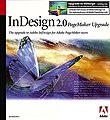Page Maker Innovation
COURTESY :-vrindawan.in
Wikipedia
Adobe Page Maker (formerly Aldus) is a discontinued desktop publishing computer program introduced in 1985 by the Aldus Corporation on the Apple Macintosh. The combination of the Macintosh’s graphical user interface, Page Maker publishing software, and the Apple Laser Writer laser printer marked the beginning of the desktop publishing revolution. Ported to PCs running Windows 1.0 in 1987, Page Maker helped to popularize both the Macintosh platform and the Windows environment.

A key component that led to Page Maker’s success was its native support for Adobe Systems’ PostScript page description language. After Adobe purchased the majority of Aldus’s assets (including Free Hand, Press Wise, Page Maker, etc.) in 1994 and subsequently phased out the Aldus name, version 6 was released. The program remained a major force in the high-end DTP market through the early 1990s, but new features were slow in coming. By the mid-1990s, it faced increasing competition from Quark X Press on the Mac, and to a lesser degree, Ventura on the PC, and by the end of the decade it was no longer a major force. Quark proposed buying the product and cancelling it, but instead, in 1999 Adobe released their “Quark Killer”, Adobe In Design. The last major release of Page Maker came in 2001, and customers were offered In Design licenses at a lower cost.
- Aldus Page maker 1.0 was released in July 1985 for the Macintosh and in December 1986 for the IBM PC.
- Aldus Page maker 1.2 for Macintosh was released in 1986 and added support for PostScript fonts built into Laser Writer Plus or downloaded to the memory of other output devices. Page Maker was awarded a Codie award for Best New Use of a Computer in 1986. In October 1986, a version of Page maker was made available for Hewlett-Packard’s HP Vectra computers. In 1987, Page maker was available on Digital Equipment’s VAX station computers.
- Aldus Page maker 2.0 was released in 1987. Until May 1987, the initial Windows release was bundled with a full version of Windows 1.0.3; after that date, a “Windows-runtime” without task-switching capabilities was included. Thus, users who did not have Windows could run the application from MS-DOS.
- Aldus Page maker 3.0 for Macintosh was shipped in April 1988. Page Maker 3.0 for the PC was shipped in May 1988 and required Windows 2.0, which was bundled as a run-time version. Version 3.01 was available for OS/2 and took extensive advantage of multi threading for improved user responsiveness.
- Aldus Page Maker 4.0 for Macintosh was released in 1990 and offered new word-processing capabilities, expanded typographic controls, and enhanced features for handling long documents. A version for the PC was available by 1991.
- Aldus Page Maker 5.0 was released in January 1993.
- Adobe Page Maker 6.0 was released in 1995, a year after Adobe Systems acquired Aldus Corporation.
- Adobe Page Maker 6.5 was released in 1996. Support for versions 4.0, 5.0, 6.0, and 6.5 is no longer offered through the official Adobe support system. Due to Aldus’ use of closed, proprietary data formats, this poses substantial problems for users who have works authored in these legacy versions.
- Adobe Page Maker 7.0 was the final version made available. It was released 9 July 2001, though updates have been released for the two supported platforms since. The Macintosh version runs only in Mac OS 9 or earlier; there is no native support for Mac OS X, and it does not run on Intel-based Macs without Sheep Shaver. It does not run well under Classic, and Adobe recommends that customers use an older Macintosh capable of booting into Mac OS 9. The Windows version supports Windows XP, but according to Adobe, “Page Maker 7.x does not install or run on Windows Vista.”
Development of Page Maker had flagged in the later years at Aldus and, by 1998, Page Maker had lost almost the entire professional market to the comparatively feature-rich Quark X Press 3.3, released in 1992, and 4.0, released in 1996. Quark stated its intention to buy out Adobe and to divest the combined company of Page Maker to avoid anti-trust issues. Adobe rebuffed the offer and instead continued to work on a new page layout application code-named “Shuksan” (later “K2”), originally started by Aldus, openly planned and positioned as a “Quark killer”. This was released as Adobe In Design 1.0 in 1999.
The last major release of Page Maker was 7.0 in 2001, after which the product was seen as “languishing on life support”. Adobe ceased all development of Page Maker in 2004 and “strongly encouraged” users to migrate to In Design, initially through special “In Design Page Maker Edition” and “Page Maker Plug-in” versions, which added Page Maker’s data merge, bullet, and numbering features to In Design, and provided Page Maker-oriented help topics, complimentary Myriad Pr fonts, and templates. From 2005, these features were bundled into In Design CS2, which was offered at half-price to existing Page Maker customers.
No new major versions of Adobe Page Maker have been released since, and it does not ship alongside Adobe In Design.
BYTE in 1989 listed Page Maker 3.0 as among the “Distinction” winners of the BYTE Awards, stating that it “is the program that showed many of us how to use the Macintosh to its full potential”.
Adobe Page Maker file formats use various filename extensions, including PMD, PM3, PM4, PM5, PM6 and P65; these sound be able to be opened in the applications Collabora Online, LibreOffice or Apache Open Office, they can then be saved into the Open Document format or other file formats.

